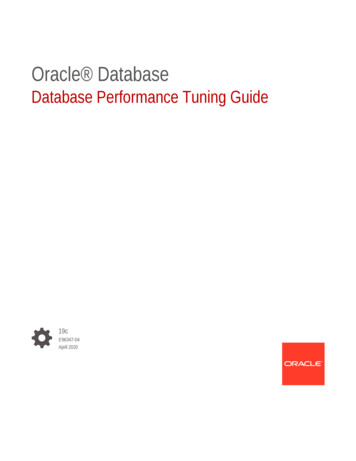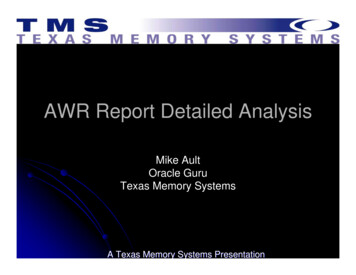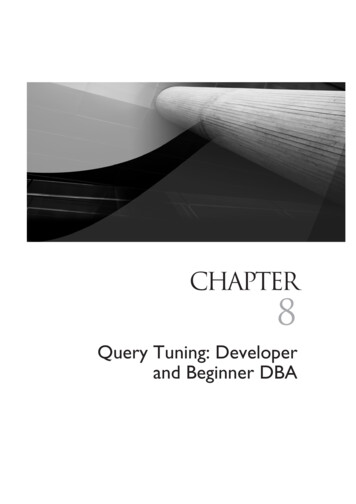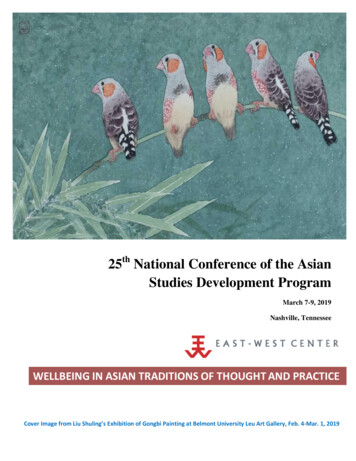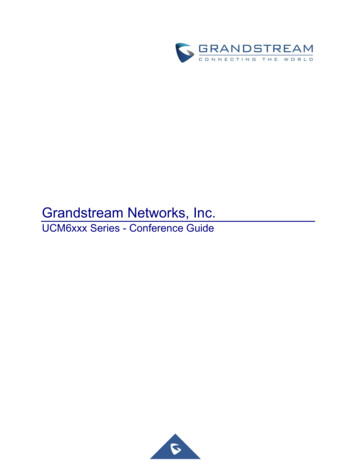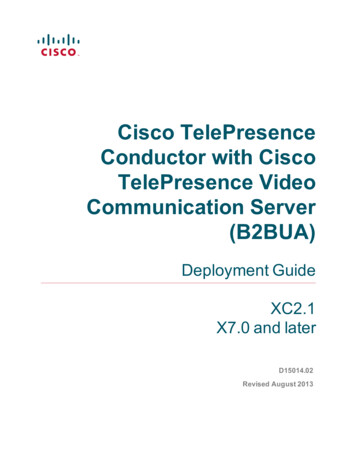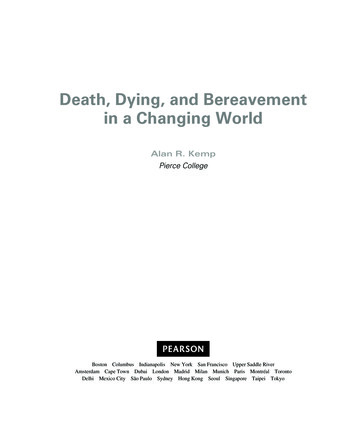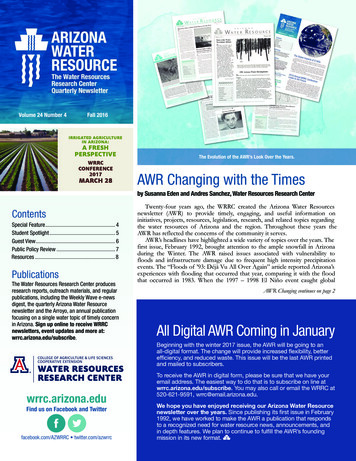
Transcription
Volume 24 Number 4Fall 2016IRRIGATED AGRICULTUREIN ARIZONA:A FRESHPERSPECTIVEWRRCCONFERENCE2017MARCH 28The Evolution of the AWR’s Look Over the Years.AWR Changing with the Timesby Susanna Eden and Andres Sanchez, Water Resources Research CenterContentsSpecial Feature. 4Student Spotlight. 5Guest View. 6Public Policy Review. 7Resources . 8PublicationsThe Water Resources Research Center producesresearch reports, outreach materials, and regularpublications, including the Weekly Wave e-newsdigest, the quarterly Arizona Water Resourcenewsletter and the Arroyo, an annual publicationfocusing on a single water topic of timely concernin Arizona. Sign up online to receive WRRCnewsletters, event updates and more at:wrrc.arizona.edu/subscribe.wrrc.arizona.eduFind us on Facebook and Twitterfacebook.com/AZWRRC twitter.com/azwrrcTwenty-four years ago, the WRRC created the Arizona Water Resourcesnewsletter (AWR) to provide timely, engaging, and useful information oninitiatives, projects, resources, legislation, research, and related topics regardingthe water resources of Arizona and the region. Throughout these years theAWR has reflected the concerns of the community it serves.AWR’s headlines have highlighted a wide variety of topics over the years. Thefirst issue, February 1992, brought attention to the ample snowfall in Arizonaduring the Winter. The AWR raised issues associated with vulnerability tofloods and infrastructure damage due to frequent high intensity precipitationevents. The “Floods of ’93: Déjà Vu All Over Again” article reported Arizona’sexperiences with flooding that occurred that year, comparing it with the floodthat occurred in 1983. When the 1997 – 1998 El Niño event caught globalAWR Changing continues on page 2All Digital AWR Coming in JanuaryBeginning with the winter 2017 issue, the AWR will be going to anall-digital format. The change will provide increased flexibility, betterefficiency, and reduced waste. This issue will be the last AWR printedand mailed to subscribers.To receive the AWR in digital form, please be sure that we have youremail address. The easiest way to do that is to subscribe on line atwrrc.arizona.edu/subscribe. You may also call or email the WRRC at520-621-9591, wrrc@email.arizona.edu.We hope you have enjoyed receiving our Arizona Water Resourcenewsletter over the years. Since publishing its first issue in February1992, we have worked to make the AWR a publication that respondsto a recognized need for water resource news, announcements, andin depth features. We plan to continue to fulfill the AWR’s foundingmission in its new format.
AWR Changing continued from page 1attention, the AWR published four special El Niño News issues,informing Arizona water professionals and others interested inwater affairs of plans, projects, and activities relating to weatheraffected by El Niño. The early years of the Central ArizonaProject (CAP) appeared in several AWR issues when Arizona’slow usage of its Colorado River water allocation preoccupiedwater administrators. In the 21st Century, the drought affectingthe Southwest United Stated shifted AWR’s attention to securingwater supplies, conservation, and reuse.The AWR began as a monthly and for many years appearedon a bimonthly basis. Joe Gelt edited the AWR from its inceptionand wrote most of its stories, keeping a format that drew onSouthwestern Indian themes. This Southwestern look and itstwo-color format—turquoise and black—came to be identifiedwith the Gelt years. His unique style was appreciated by AWRreaders throughout his 19-years as editor.Examples of Joe Gelt’s imprint on the AWR abound. Forthe March-April 2008 issue, he commemorated the contributionof Dr. Sol Resnick to the WRRC, 50 years after its founding asthe University of Arizona Institute for Water Utilization. Thefeature article reproduced Dr. Resnick’s recollections of theInstitute’s beginnings and contained a photograph of Resnick’sgrandson, born in 2007, two years after his death.A poem by Alison Hawthorne Deming, who was theDirector of the University of Arizona Poetry Center from 1990to 2002, led the June-July 1995 issue. It celebrated the perfectsynchronization of water and nature. Other feature articlesincluded news about archeological findings of prehistoricirrigation canals constructed by Arizona’s earliest inhabitantsapproximately three thousand years ago. In a futuristic vein,the AWR described the concept of high-rise greenhouse-likestructures for crop production that conserve land and water.Featuring a photograph titled “The Face of Drought”, theface of a young woman caked in cracking mud, he presenteda special edition covering the Arizona-Israeli-Palestnian WaterManagement and Policy Workshop held in Tucson August31-September 2, 2009.After Gelt’s retirement, the current quarterly schedule wasadopted and Susanna Eden became the new AWR Editor,bringing changes, including a full-color look, which came in 2013with a updated redesign. Eden also increased the contributionsof graduate student writers and others to the content.Graduate student Stephan Elizander Przybylowiczcontributed a feature on Hydrophilanthropy, a practice thatembodies humanitarian actions oriented to increase and sustainclean water in areas of need. Other student-written articlesincluded a personal account of the water use of a ranchingfamily by Alanna Riggs; and an analysis of how science,technology, engineering and math (STEM) fields are redefiningand strengthening water education in Arizona written by JacobPrietto.The structure of the AWR has evolved throughout the years.The Water Vapors column linked all the members of the watercommunity for many years, with items about conferences andworkshops, community views and concerns, and the activities ofpeople working in the water field. In the early 2000s the AWRincorporated Special Supplements by the U.S. Geological Surveyand others to display and publicize water-related research andprojects. The AWR has offered the opportunity to professionalsfrom outside the WRRC to express their opinions and sharetheir knowledge on a wide range of topics in the Guest Viewcolumn. In recent years the AWR has shown a spotlight on thecontributions of WRRC’s students, publishing brief biographiescontaining their remarkable accomplishments and aspirations.After her firs appearance in a Guest View, WRRC DirectorSharon B. Megdal has written a Public Policy Review column,providing her personal and professional insight on policy issues,in each AWR from 2002 to the present.Keeping an eye toward the future, the AWR will continue toevolve. Look for the Winter 2017 issue in its all-digital format inJanuary.Projects Featuring Water Resources Receive Environmental HonorsAwards for Environmental Excellence, presented at the annualawards banquet on September 10, rewarded efforts by communities,fi ms, organizations, and individuals for promoting sustainability,conservation, and preservation of Arizona’s natural assets. Waterrelated projects received a fair share of awards, which were presentedby Arizona Forward, an organization created to mobilize support forthe benefit of communities, the economy, and the environment. Ofthe 16 first place Crescordia Awards, Tucson Water took two: one forits Advanced Oxidation Process Project, which uses first-in the-nationtechnology to improve contaminant removal at the Tucson InternationalAirport Area Groundwater Remediation Project, and a second for itsConservation and Education Program. The El Rio Design GuidelinesSusanna Eden, Cody and Jatta Sheehy, and John and Lynn MarieBooth with the Crescordia Award for Beyond the Mirage.and Planning Standards, developed through a partnership among thecities of Avondale, Goodyear, and Buckeye, Maricopa County, andthe Flood Control District of Maricopa County, also received a top honor. Finally, Beyond the Mirage, a project involving,social media, the internet, television, and person-to-person communication to raise public knowledge and awareness about thecomplex world of water, won a Crescordia in the category of Environmental Education/Communication. Tucson Water alsowon an Award of Merit, for its Clearwater Recharge and Recovery Project, as did Pima County Regional Flood Control District,for Paseo De Las Iglesias, and the City of Phoenix, for the PHX Water Smart program. Phoenix also won for Phoenix Investsto Protect Water Supplies, an investment in protection of watershed forests.2Arizona Water Resource / Fall 2016 / wrrc.arizona.edu
NewsStudy Estimates the Costs of Sea LevelRise on HousingThe upside of lacking a coastline is that Arizona home ownersare not personally affected by sea level rise, but Zillow, the realestate web site that allows you to look up comparative homevalues, has identified rising sea levels and associated floodingas a threat nearly as costly as the 2008 housing bust. Zillowmapped projected sea levels for the year 2100 and the currentlyexisting houses that would be inundated. The numbers run intomillions of homes and billions of dollars. They used NationalOceanographic and Atmospheric Administration (NOAA) mapsalong with their own real estate data to arrive at their conclusions.The almost 1.9 million U.S. homes at risk—that’s about 2 percentof the total—are worth 882 billion. Some states like Florida andHawaii will lose a significant percentage of their housing to thesea: 12.5 percent and 9 percent, respectively. The Zillow reportpoints out that 2100 is a long way off and policy and homebuyerchoices are likely to either mitigate or exacerbate the problem,or both.Tucson Water Makes a Splash in WaterReuseTucson has embraced water reuse as part of its waterportfolio and is gaining recognition for its efforts. Water reuseorganizations honored Tucson Water for its leadership in resourcerecovery, watershed protection, culture change, and communitypartnering. The Water Environment Federation, the NationalAssociation of Clean Water Agencies, the Water Environment& Reuse Foundation, and WateReuse jointly recognized Tucsonwater as winner of their “Utility of the Future Today” program.A forward-looking water reuse project, in which TucsonWater participated, also took a prize from the WaterReuseorganization for “Project of the Year”. The six-month pilot testevaluated alternative non-RO-based potable reuse treatment,including short-term soil aquifer treatment, nanofil ration, ozone,biological activated carbon filtration, and granular activatedcarbon adsorption. The innovative and sustainable potable reusetreatment scheme was successful in producing highly purifiedwater.New Program Will Help Tucson’s LowIncome Families Harvest RainwaterThe City of Tucson has approved a first-of-its-kind programthat will make it possible for low-income families to participatein its rainwater harvesting program. A water conservation tool,rainwater harvesting also is used to support new trees. Increasingshade from trees can reduce electric bills as well as reduce theimpacts of the urban heat island. The program will providegrants and loans for low-income families to install rainwatercollection systems. A system with a medium-size tank can cost 2,000 or more. People are already lining up for the program.The Sonoran Environmental Research Institute (SERI) is taskedwith immediate launch of a one-year pilot program, which willprovide 150,000 within the current fiscal year. The City has setaside 300,000 for the program, with the goal of helping 100families harvest rainwater at their homes. The program is slatedto be extended for an additional three years.ASU and Smithsonian Team on WaterManagement ExhibitionWaterSim America, a new interactive computer simulationcreated by Arizona State University and the SmithsonianInstitution, will be touring Florida, Illinois, Minnesota, Idaho,and Wyoming this year. Designed for the general public, theexhibition shows the complexity of state level water management,especially in the face of drought and climate change. ASU’sDecision Center for a Desert City (DCDC), which works withwater leaders to support informed decision-making, and theSmithsonian’s Museum on Main Street, which brings exhibitionsto small towns across the United States, conceived this project,part of the Smithsonian’s “Water/Ways” exhibition, as a way toeducate people about what can be done to effect positive changein the management of their water.Researchers at DCDC modified the Center’s WaterSimprogram to work with water issues on a state level. Each statehas its own model in the WaterSim America simulation. Themodel can be asked to show what would be the impact of acertain water management policy, population growth scenario, ordrought condition. When water demands and supply fall out ofbalance, users try to bring them back into balance through policychoices. Users learn through interaction about how physical andsocial factors could affect their state’s water future.NSF Funds NAU Project for FoodEnergy-Water System MapFood, energy, and water are connected in complex ways,and understanding these connections has become a priorityfor policy development. The National Science Foundation hasawarded Benjamin Ruddell, an associate professor in NAU’snew School of Informatics, Computing and Cyber Systems a 3 million grant to create and exploit the first detailed mappingof the Food, Energy, and Water System (FEWS) of theUnited States. The project ,“Mesoscale Data Fusion to Mapand Model the U.S. Food, Energy and Water (FEW) System,”brings together an interdisciplinary team to integrate multiplesystem components, such as regional trade, river basins andaquifers, irrigation districts, crop belts, states, tribes, countiesand cities, power grids, and climate, for a comprehensive viewof their dynamic interactions. The map and its associated datawill be used to examine FEWS network trade-offs betweenperformance and sustainability, vulnerability to stresses andshocks, and the role of cities. A publicly accessible web site willenable visualization of how local actions propagate throughoutthe food, energy, and water system. This work builds on theU.S. National Water-Economy Project, which mapped the U.S.hydro-economic network, in support of efforts by municipalitiesand corporations to improve their sustainability and resiliencewith respect to water.Arizona Water Resource / Fall 2016 / wrrc.arizona.edu3
Special FeatureArizona Agriculture Using Recycled Waterby Jean E. McLain, Associate Director, WRRCAgricultural production is vital to Arizona, contributingover twelve billion dollars to the State’s economy each year. Itis also by far the largest water-consuming sector, accountingfor about 70 percent of water demand in Arizona. With watershortages looming, water recycling could give some agriculturaloperations a much-needed additional water supply.While no federal regulations exist pertaining to recycledwater use for agricultural irrigation, there are recommendationsset forth by the U.S. government. Originally drafted in 1980,the United States Environmental Protection Agency (EPA)Guidelines for Water Reuse established minimum standardsand criteria recommended for the use of recycled water foragricultural irrigation. The EPA guidelines, which were updatedin 2004 and again in 2012 to conform to advances in watertreatment technologies, provide states with criteria to establishtheir own regulations on the use of recycled water.Using the EPA guidelines as a model, the State of Arizonahas established regulations on the use of recycled water foragricultural irrigation. These regulations are being revisited(see Guest View this issue), but the rules governing agriculturalirrigation are not likely to change substantially.Arizona’s recycled water standards establish five classes ofrecycled water, each requiring a specific minimum treatmentin order to meet a limited set of numeric water quality criteria(TABLE 1). Class A is the required minimum quality of recycledwater for irrigation of food crops, including vegetables thatare eaten raw, while Class B suffices for surface irrigation ofan orchard or vineyard. Forage, fib r, and seed crops requireeven less stringent (Class C) water quality. Though Arizona’sagriculture industry is extremely diversified, producing cotton,alfalfa, wheat, citrus, and fresh vegetables, all of which can belegally irrigated with recycled wastewater, the majority of cropsWater Classcurrently being irrigated with recycled water are non-edible cropssuch as alfalfa, feed corn, cotton, and grasses.Most agricultural use occurs near metropolitan areas, wherehigh demand for freshwater sources exists and where water doesnot have to be moved great distances from wastewater treatmentplants (WWTPs) to agricultural fields.It is diffi ult to gauge the full extent of recycled wateruse for agriculture in Arizona, but a study by a University ofArizona graduate student, Jeremy Cusimano, found that in 2012,permitted reuse amounted to 140,000 acre-feet (AF) in Centraland Eastern portions of the state. In addition, the Gila RiverIndian Community receives 40,000 AF in treated water from thecities of Chandler and Gilbert. In the Yuma area an abundantand extremely low-cost supply of Colorado River water hasprecluded widespread use of recycled municipal or industrialwastewater for agricultural irrigation.In addition to permitted use, incidental reuse for agriculturalirrigation from rivers that contain treated effluent is undoubtedlycommon, as treated wastewater is often discharged fromWWTPs into dry riverbeds. For example, approximately 50 milessouthwest of Phoenix, downstream irrigators in the Gila Bendarea use the treated wastewater that dominates the flow of theGila River.In many cases, the use of recycled water for agriculture isa money-saving measure. While recycling water is energyintensive, performing wastewater recycling on site or close toan agricultural field reduces the energy needed to move waterlonger distances or pump water from deep within an aquifer.On the other hand, growers can face several challenges withrecycled water use. Often, recycled water is only readily availablewhen irrigation demand for crops is low, such as in the wintermonths. In summer, increased demand for water to irrigate parksand other municipal green spaces decreases the availability ofrecycled water for agricultural irrigation.Water Quality CriteriaA 24-hour average turbidity 2 NTU (measure of clarity);No detectable fecal coliform bacteria in four of the last seven daily water samples taken, andThe maximum concentration of fecal coliform bacteria in a single water sample 23 per 100 mL;Total nitrogen 10 mg per L.A 24-hour average turbidity 2 NTU (measure of clarity);No detectable fecal coliform bacteria in four of the last seven daily water samples taken, andThe maximum concentration of fecal coliform bacteria in a single water sample 23 per 100 mL.B The concentration of fecal coliform bacteria in four of the last seven daily water samples taken 200 per 100 mL;The maximum concentration of fecal coliform bacteria in a single water sample is 800 per 100 mL.Total nitrogen 10 mg per L.B The concentration of fecal coliform bacteria in four of the last seven daily water samples taken 200 per 100 mL;The maximum concentration of fecal coliform bacteria in a single water sample is 800 per 100 mL.C The concentration of fecal coliform bacteria in four of the last seven daily water samples taken 1000 per 100 mL;The maximum concentration of fecal coliform bacteria in a single water sample is 4000 per 100 mL.TABLE 1. Arizona Recycled Water Standards. Source: Arizona Administrative Code, Title 18, Chapter 11, Article 34Arizona Water Resource / Fall 2016 / wrrc.arizona.edu
Growers also may be reluctant to increase dependence onrecycled water due to instability in long-term supply. In manycases, newly constructed WWTPs provide growers with recycledwater only temporarily until supplies are diverted to other uses.For example, if urban development occurs near a WWTP,recycled water can be transferred away from agricultural use toirrigate urban landscapes.Even when recycled water is readily available, growers maybe reluctant to utilize it for crop irrigation. One issue, perhapsthe most difficult to overcome, is the negative public perceptionthat may remain regarding the use to recycled water for foodcrops. A 2008 survey of Arizona residents by Channah Rock,a University of Arizona researcher, and colleagues at NorthernArizona University found that while 58 percent of Arizonaresidents supported the use of recycled water for irrigation ofnon-edible crops, far fewer, - 28 percent, - found this policyacceptable for edible crops. Thus, it would be likely that growerswith a range of water supply options may choose not to irrigatewith recycled water.Another issue associated with recycled water use is salinity.Recycled water typically contains a concentration of totaldissolved solids that ranges from 800 to 1400 parts per million(PPM), and can be higher in some cases. In comparison, waterdelivered through Central Arizona Project canals in 2013averaged about 600 PPM.The high salt concentration of recycled water can bemanaged in agriculture by periodically applying a sufficientamount of excess irrigation water to flush salts below the rootzone. Put simply, a grower can maintain the root zone saltbalance by applying enough excess water to carry the sameamount of salt out of the soil as the water itself brings in. Ifrecycled water is readily available in adequate supplies, the costsavings of using recycled water instead of CAP or groundwatermay make applying excess irrigation water to leach salts worththe additional cost. It is also important to note that many cropsirrigated in Arizona with recycled water have a fairly hightolerance to salinity; these include barley, wheat, Sudan grasses,date palms, and cotton.Finally, grower concerns may be related to the presenceof contaminants of emerging concern in recycled wastewater.Though wastewater technology has made rapid advances in theproduction of a clean, safe water, very low (parts per trillion)levels of contaminants, including pharmaceuticals and cleaningagents, may remain. Some recent research has suggested thatplants have the ability to take up such contaminants and thus,bring them into the human food supply. Many of these studies,however, involved hydroponic systems and excessively highconcentrations of contaminants, while well-controlled fieldstudies do not show uptake for the most part. Clearly, this is anarea requiring more attention.As Arizona’s population increases and demand for freshwater supplies escalate, the agriculture industry will probablybecome more dependent on recycled water. As Arizonagrows, recycled water supplies will grow and will be availableto meet more of the State’s water demand. With the growingavailability of recycled water, it is important both to monitor itsuse in agricultural irrigation and to provide growers with a fullaccounting of its benefits and concerns regarding its use.Student SpotlightArizona Water Resource is published quarterlyby the University of Arizona Water ResourcesResearch Center. AWR accepts news,announcements, and other information fromall organizations.Brendan Murphy, Computer Scienceand East Asian StudiesBrendan Murphy is a third-year undergraduate studentand National Merit Scholar at the University of Arizona,working towards a BS in Computer Science and a BA inEast Asian Studies with a Japanese language emphasis.He currently is the president of the Japanese Associationof the University of Arizona, working to create anenvironment of cultural exchange between the Japaneseand local students.Before entering the University of Arizona, he servedas a missionary for The Church of Jesus Christ of Latter-Day Saints in thesouthern part of Japan, sharing his beliefs in Fukuoka, Hiroshima, Nagasaki,Okinawa, and even the Sakishima Islands, learning both the Japaneselanguage and culture, skills which he today employs mostly in club activities,translation, and in working with Japanese-related linguistic databases.At the WRRC, Brendan works as a Student Systems Administrator,handling both simple and complex computer troubleshooting, service, andmaintenance. As one of the only employees with no background in waterrelated research, his activities often involve figuring out creative solutions toIT problems unique to the center.Brendan plans to continue on in interdisciplinary research and is currentlylooking towards a Master’s program in computational linguistics, a fieldwhere he hopes to be able to combine his background in computer science,linguistics, and Japanese.Editor: Susanna EdenDesigner: John PolleNewsletter Link: wrrc.arizona.edu/publications/awrWRRC Website: wrrc.arizona.eduWRRC Director: Dr. Sharon B. MegdalArizona Water ResourceWater Resources Research CenterCollege of Agriculture and Life SciencesThe University of Arizona350 North Campbell AvenueTucson, Arizona 85719 USA520.621.9591FAX: 520.792.8518Email: wrrc@email.arizona.eduThe AWR is supported by the Water, Environmental, andEnergy Solutions (WEES) Initiative.Arizona Water Resource / Fall 2016 / wrrc.arizona.edu5
Guest ViewAfter 90 Years of Reusing ReclaimedWater in Arizona, What’s in Store?If we look at reuse volumes, the numbers are alsoastonishing. According to an ASU study, 82 percent of alltreated wastewater generated within the Phoenix Activeby Chuck Graf, Arizona Department of Environmental Quality Management Area (60 percent of Arizona’s population) isbeneficially reused or re harged.With this much reuse already occurring, what are the trends?Arizona has a long history of putting treated wastewater tobeneficial use, in fact, 90 years of history. In 1926, at Grand First, communities currently reusing reclaimed water often haveCanyon Village on the South Rim, the firs wastewater treatment excess water in the winter when turf and landscape demands areplant in the US built specifically for water reuse began supplying reduced. Consequently, expect to see more recharge of excesswater at new or expanded rechargewater for power generation, Santafacilities to gain credits from ADWR.Fe Railroad steam locomotives, andSecond, expect to see a transitionflushing toilets. The local power stationfrom lower-valued uses, such as turfand steam locomotives are long gone,irrigation, to industrial or other higherbut reclaimed water continues to be usedvalued uses. Third, expect to seeto this day for landscape irrigation and,more reuse by smaller communities.yes, for flushing toilets.Currently, only 40 percent of the 200 orIt wasn’t until 1972, though, that theso smaller wastewater treatment plantsArizona Department of Health Servicesunder ADEQ permit are distributingadopted the state’s first rules governingreclaimed water for reuse. Althoughreclaimed water quality and use, somevolumes might be small, the suppliesof the first in the nation. Fast forwardmay be critical in rural areas in view ofanother decade to 1983, when Arizona’sdrought and other drivers. Also, expectlargest treatment plant, at 91st Avenueto see more plans for multi-purposein Phoenix, began supplying about 60Payson Green Valley Lakecommunity enrichment projects, suchmillion gallons per day of reclaimedSource: Chuck Grafas the Gilbert Riparian Preserve andwater to the Palo Verde NuclearPayson Green Valley Lake. In this vein,Generating Station west of Buckeye.Palo Verde, the largest nuclear power generator in the US, is reclaimed water is becoming so valuable that riparian areasunique in the world for being wholly cooled by reclaimed water. dependent on its flows are coming under pressure. Therefore,In 1999, the Arizona Department of Environmental Quality expect to see more vocal support for considering environmental(ADEQ) received clear authority from the Legislature to regulate needs and riparian enhancement as a valid end use for reclaimedthe beneficial reuse of reclaimed water, and in 2001, ADEQ water. Finally, there is a groundswell of interest by communitiestransformed the program by adopting rules that foster reuse in determining whether potable reuse can be a viable part of theirwhile protecting water quality and human health. Independently, water portfolios.Time has marched on since 2001 when ADEQ last adoptedthe Arizona Department of Water Resources (ADWR) wasadministering a program that allows accrual of credits for reclaimed water rules. New concerns and needs have arisen,recharge of treated wastewater in Active Management Areas to and treatment and monitoring technologies have advancedoffset limits on groundwater pumpage. These programs, which impressively. For this reason, on January 1 of this year, ADEQspurred a dramatic increase in the volume of wastewater treated opened a docket with the Secretary of State to revise its reclaimedfor reuse and recharge, established Arizona as a national leader in water rules. ADEQ received more than 300 comments duringinformal listening session workshops held around the state earlierthe regulation and practice of reclaimed water reuse.Three regulatory components mesh to create Arizona’s well- this year. ADEQ anticipates revising the rules in two or threeregarded reclaimed water program. First, as part of its aquifer installments, aiming for adoption of the first installment, afterprotection program, ADEQ sets stringent treatment standards formal public comment, at the end of 2016 or in early 2017. Thisfor new and expanding wastewater treatment plants. These first installment will clarify ambiguities, correct errors, and foldstandards include reduction of total nitrogen to below drinking some less complex technical and administrative improvementswater limits a
low usage of its Colorado River water allocation preoccupied . cities of Avondale, Goodyear, and Buckeye, Maricopa County, and the Flood Control District of Maricopa County, also received a top honor. Finally, Beyond the Mirage, a project involving, social media, the internet, television, and person-to-person communication to raise public .
